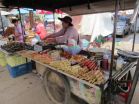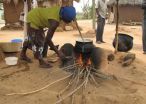(Press-News.org) Stem cells are a valuable resource for medical and biological research, but are difficult to study due to ethical and societal barriers. However, genetically manipulated cells from adults may provide a path to study stem cells that avoid any ethical concerns. A new video-protocol in JoVE (Journal of Visualized Experiments), details steps to generate human induced pluripotent stem cells (iPSC) from cells in the peripheral blood. The technique has been developed by Boston University's Dr. Gustavo Mostoslavsky and his colleagues.
Stem cells are unique because they can self-renew, differentiate into multiple cell types (pluripotency), and are immortal. Fertilized eggs produce embryonic stem cells with the potential to differentiate into any other cell type. Despite their value, embryonic stem cells pose a variety of ethical, legal and political implications that cause scientists to look for less controversial paths of study. "As opposed to human embryonic stem cells that originate in fertilized eggs, human induced pluripotent stem cells can be generated from any cell, and there are no ethical barriers to this," Dr. Mostoslavsky explains.
"Our article describes a methodology to obtain high quality, induced pluripotent stem cell lines," Dr. Mostoslavsky continues. His work is particularly interesting to the stem cell research community because "blood is an easily accessible sample for most laboratories. Our procedure uses a vector we created and produced a few years ago, and is very efficient. Our colleagues are very interested in that high efficiency. We published in JoVE because there are some technical details in the protocol that are best conveyed with a video-protocol. "
Dr. Mostoslavsky uses induced pluripotent stem cells to model genetic lung diseases, providing a fast track to study rare diseases in the laboratory. This technique will prove a valuable time and cost saving resource for other scientists interested in genetic disorders. The video-protocol was published in JoVE on October 31, 2012. JoVE Senior Science Editor Dr. Nandita Singh tells us, "We are excited to describe the generating of human iPSC using a lentiviral vector the Yamanaka factors. This vector was developed in Dr. Mostoslavsky's lab. The ease of obtaining the tissue sample combined with the high efficiency of reprogramming makes this method a very valuable tool in the field. The JoVE format will help the scientific community to accurately replicate this methodology.
###
Mostoslavsky et. al. http://www.jove.com/video/4327/generation-human-induced-pluripotent-stem-cells-from-peripheral-blood
About JoVE, The Journal of Visualized Experiments:
JoVE, The Journal of Visualized Experiments, is the first and only PubMed/MEDLINE-indexed, peer-reviewed journal devoted to publishing scientific research in a video format. Using an international network of videographers, JoVE films and edits videos of researchers performing new experimental techniques at top universities, allowing students and scientists to learn them much more quickly. As of November 2012, JoVE has published video-protocols from an international community of nearly 6,000 authors in the fields of biology, medicine, chemistry, and physics.
URL: www.jove.com
To link to this release, please use this link: http://www.jove.com/about/press-releases/48/novel-technique-to-produce-stem-cells-from-peripheral-blood
Contact:
Neal Moawed
Academic Liaison & Marketing Associate
The Journal of Visualized Experiments
p. 617.945.9051
e. neal.moawed@jove.com END
Novel technique to produce stem cells from peripheral blood
2012-11-01
ELSE PRESS RELEASES FROM THIS DATE:
MIT and Northwestern economists find kinship networks play key role to access credit
2012-11-01
(Nov. 1, 2012 – Chicago, IL) In times of financial hardship, or when opportunities arise, the ability to borrow can be critical. Some people rely on commercial lenders, while others depend on relatives, especially in developing countries. But a new study shows that the presence of banks and relatives together are better than any one source individually.
The research, funded by the Consortium on Financial Services and Poverty (CFSP), suggests that not every household in a village needs to use the banking system directly in order to benefit in terms of buffering consumption, ...
Caffeine's effect on the brain's adenosine receptors visualized for the first time
2012-11-01
Reston, Va. (November 1, 2012) – Molecular imaging with positron emission tomography (PET) has enabled scientists for the first time to visualize binding sites of caffeine in the living human brain to explore possible positive and negative effects of caffeine consumption. According to research published in the November issue of The Journal of Nuclear Medicine, PET imaging with F-18-8-cyclopentyl-3-(3-fluoropropyl)-1-propylxanthine (F-18-CPFPX) shows that repeated intake of caffeinated beverages throughout a day results in up to 50 percent occupancy of the brain's A1 adenosine ...
USDA patents method to reduce ammonia emissions
2012-11-01
Capturing and recycling ammonia from livestock waste is possible using a process developed by U.S. Department of Agriculture (USDA) researchers. This invention could help streamline on-farm nitrogen management by allowing farmers to reduce potentially harmful ammonia emissions and concentrate nitrogen in a liquid product to sell as fertilizer.
The work was conducted by Agricultural Research Service (ARS) scientists Matias Vanotti and Ariel Szogi at the agency's Coastal Plains Soil, Water and Plant Research Center in Florence, S.C. ARS is USDA's chief intramural scientific ...
Solving a biological mystery
2012-11-01
Harvard scientists have solved the long-standing mystery of how some insects form the germ cells – the cellular precursors to the eggs and sperm necessary for sexual reproduction – and the answer is shedding new light on the evolutionary origins of a gene that had long been thought to be critical to the process.
As described in a November 1 paper published in Current Biology, a team of researchers led by Associate Professor of Organismic and Evolutionary Biology Cassandra Extavour discovered that a cricket, a so-called "lower" insect, possess a variation of a gene, called ...
Living donors fare well following liver transplantation
2012-11-01
Researchers in Japan report that health-related quality of life (HRQOL) for donors following living donor liver transplantation (LDLT) was better than the general Japanese population (the norm). This study—one of the largest to date—found that donors who developed two or more medical problems (co-morbidities) after donation had significantly decreased long-term HRQOL. Full findings are published in the November issue of Liver Transplantation, a journal of the American Association for the Study of Liver Diseases (AASLD).
The shortage of viable donor organs continues to ...
A protein’s role in helping cells repair DNA damage
2012-11-01
BUFFALO, N.Y. -- In a new study, University at Buffalo scientists describe the role that a protein called TFIIB plays in helping cells repair DNA damage, a critical function for preventing the growth of tumors.
The research appeared online on Oct. 30 in the Proceedings of the National Academy of Sciences (PNAS) Early Edition.
TFIIB, short for "transcription factor II B," is a protein that binds to DNA in cells to initiate the process of transcription, which is critical for building new proteins.
When DNA damage occurs, TFIIB is altered in a way that halts general transcription, ...
New target discovered for food allergy treatment
2012-11-01
Researchers at National Jewish Health have discovered a novel target for the treatment of food allergies. Erwin Gelfand, MD, and his colleagues report in the October 2012 issue of the Journal of Allergy and Clinical Immunology that levels of the enzyme Pim 1 kinase rise in the small intestines of peanut-allergic mice. Inhibiting activity of Pim 1 markedly reduced the allergic response to peanuts.
"Pim 1, and its associated transcription factor, Runx3, play a crucial role in allergic reactions to peanuts," said Dr. Gelfand, senior author and chair of pediatrics at National ...
Air pollution, gone with the wind
2012-11-01
Montreal, November 1, 2012 – As urban populations expand, downtown buildings are going nowhere but up. The huge energy needs of these skyscrapers mean that these towers are not only office buildings, they're polluters with smokestacks billowing out toxins from the rooftop. Our cities are dirtier than we think. New research from Concordia University just might clean them up.
By examining the trajectory and amount of air pollution from a building to its neighbours downwind, Concordia researchers Ted Stathopoulos and Bodhisatta Hajra have come up with environmentally friendly ...
Anthropocene continues to spark scientific debate
2012-11-01
Boulder, CO, USA – How have humans influenced Earth? Can geoscientists measure when human impacts began overtaking those of Earth's other inhabitants and that of the natural Earth system? Responding to increasing scientific recognition that humans have become the foremost agent of change at Earth's surface, organizers of this GSA technical session have brought together speakers and poster presentations from a variety of sources in order to answer these questions and define the "Geomorphology of the Anthropocene."
"Anthropocene" is a fairly new term (first used ca. 2002 ...
Scientists launch international study of open-fire cooking and air quality
2012-11-01
Contact: David Hosansky
hosansky@ucar.edu
303-497-8611
National Center for Atmospheric Research/University Corporation for Atmospheric Research
Zhenya Gallon
zhenya@ucar.edu
303-497-8607
National Center for Atmospheric Research/University Corporation for Atmospheric Research
Christine Wiedinmyer
christin@ucar.edu
303-497-1414
National Center for Atmospheric Research
Mary Hayden
mhayden@ucar.edu
303-497-8116
National Center for Atmospheric Research
Scientists launch international study of open-fire cooking and air quality
BOULDER -- Expanding ...


